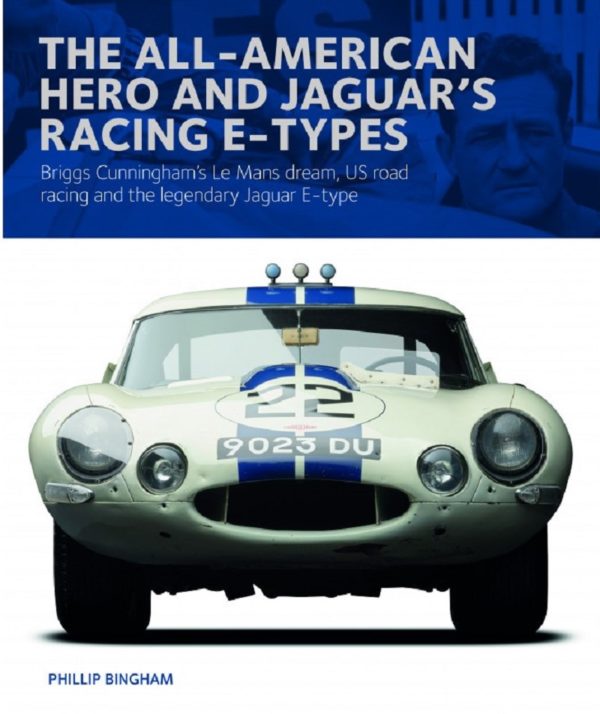
by Phillip Bingham
2020 review by James Loveridge
If you are going to inherit a large fortune then one of the best ways of putting it to use is to go motor racing, as demonstrated by Phillip Bingham in this excellent book about Briggs Swift Cunningham.
The story doesn’t really start until, after an obviously gilded youth and early manhood honing his skills as a yachtsman and operating a virtually private WW2 Air Force, hunting U Boats in the Atlantic, Briggs secured his inheritance at age 40; then he really got going.
In considerable detail, which is manifest throughout the book, Mr Bingham tells of Cunningham’s determination to win the Le Mans 24 Hours for America with an American car and engine and ideally with American drivers. Over 6 years from 1950 to 1955 interesting cars of his own make in their distinctive white and blue American livery were entered, including the hideous Le Monstre. Unfortunately Cunningham never achieved his ambition, though his cars put up some good performances, principally because they were always too heavy. Cunningham cars however did achieve considerable success at home in America.
The story continues to tell how Cunningham first became associated with Jaguar by adopting the D-Type, a promising relationship which came to an end, albeit temporary, with the 1957 fire at Browns Lane. Of particular interest is how Cunningham got involved with Jaguar’s E2A, the development vehicle to succeed the D-Type, after he had been forced to rely on other makes, including the Lister and Costin Jaguars, to continue his motor racing. It seems Jaguar weren’t too sure what to do with the one and only E2A once it was made was made, but Cunningham persuaded them to let him have it. Jaguar themselves proceeded with developing and launching the eventual E-Type whilst Cunningham raced E2A a good many times even though Jaguar seem to have intended the E-Type to be a road car. The trials and tribulations are recalled but there was not a great deal of success.
Throughout the book a good deal of attention is given to the racing activities of the Cunningham team over the years at places like Daytona, Bridgehampton and Sebring as well as subsequent entries at Le Mans. An attractive feature is the “thumbnail” sketches of people who played an important part in the history of Cunningham such as Alfred Momo, Dan Gurney, Augie Pabst, Bruce McLaren and Walt Hangsen, several of whom are probably unfamiliar to UK readers. The team’s significant racing performances are fully documented.
Briefly mentioned are Briggs’s activities as a Jaguar sales agent, manufacturer not only of his own racing cars but also of a handful of road cars. As a result of an obviously well-spent youth, his ability to take over at short notice the captaincy of America’s entry in the 1958 America’s Cup yacht race and win it is noted.
Considerable space is given to the arrival of the E-Type, its success and its racing history with the Cunningham team with its involvement in the Lightweights. The focus naturally is on the American story and how important that was to the success of this iconic car.
Given special attention is E-Type chassis number 875027, the first E-Type raced by Cunningham, accompanied by photographs of the car as it is now. The story ends with the setting up of the Cunningham Collection and its sale to old-established friends the Colliers.
The book is well up to the standards of previous Porter Press books, several of which have been reviewed on this website, though it is unfortunate that pages 15 to 18 became detached as soon as the review copy was opened, hopefully a rogue copy. It is printed on good-quality gloss paper with many well-reproduced excellent photographs.
At a cost of £60 this is a very reasonably priced book in today’s market and worth buying to get a good, broad picture of sports car racing in its post WW2 golden age, both in Europe and particularly in the USA.
Publisher: Porter Press International www.porterpress.co.uk
Price: £60.
Description: Hardback with dust-jacket (310 x 260 mm), 288 pages, illustrated in black and white and colour throughout.
ISBN: 978-1-907085-81-9







Leave a Comment